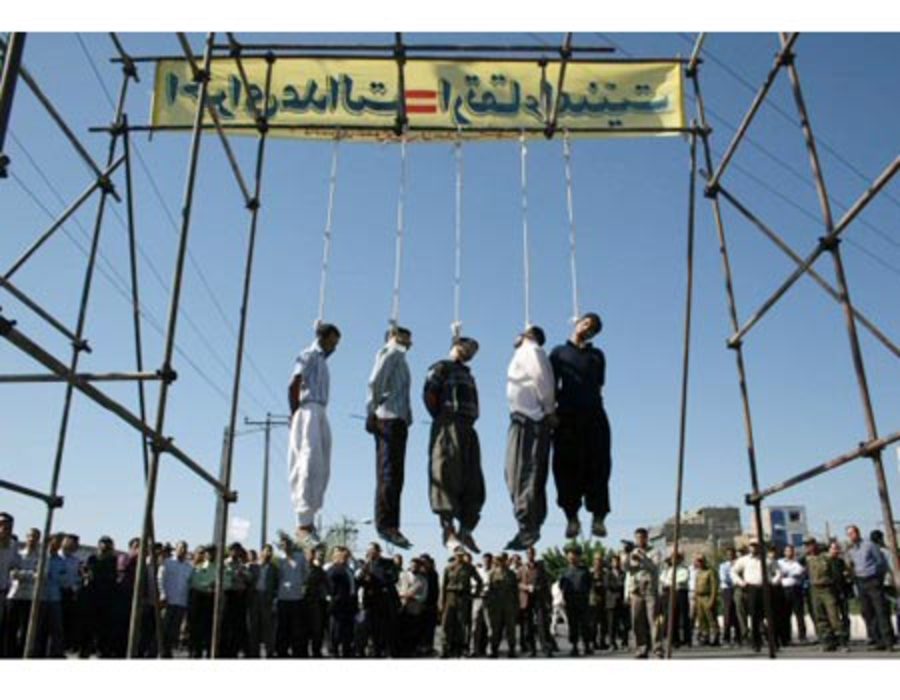
October 18-2013
The frequent practice of public executions in Iran is intended to be a deterrent to crime by dramatically demonstrating that crime does not pay.
But now, Radio Farda reports that a child who had watched public executions in Kermanshah has died play-acting what he had seen in the streets.
The 12-year-old, identified only by his first name of Mehran, placed a noose around his neck and hanged himself by mistake with the help of his younger brother.
Mokhtar Khandani, a journalist working for the Mokrian News Agency, said the boy died August 31.
Khandani traveled to the boy’s village of Kelashlulem. “I talked to the family members, with his mother, his father and his uncles,” Khandani told Radio Farda.
“They told me the younger brother prepared it, and the 12-year-old brother, Mehran, hanged himself. The younger brother thought Mehran was joking. After some time the younger brother became scared and let the grownups know. Unfortunately, when they arrived they saw the child had already passed away.”
The boys’ game lasted only a few minutes, from the time it took to throw a rope over a lamppost and for Mehran to stand on a cart and slip the noose around his neck to when his eight-year-old brother pulled the cart away.
Then, suspended in the air, Mehran did a gallows dance that did not just imitate a public hanging — it was one.
According to the latest report by Amnesty International, Iran executed 560 people in 2012. That includes 330 executions acknowledged by the government in the Iranian press, 195 executions reported by activists but not acknowledged by the government, and 35 suspected secret executions in Vakilabad prison in Mashhad.
Most of the executions were for drug-related offenses. Most took place inside prisons. But 63 executions last year—or more than 10 percent —were carried out in public.
Most of the public executions in Iran use a crane for a makeshift gallows. The prisoner—blindfolded, handcuffed, and accompanied by an armed guard—stands on a platform before a crowd in a stadium or square. Often several condemned men are hung in succession.
While many in the crowd look on in shock, others jeer and laugh. In fact, in a country with few forms of public entertainment, many see a public execution as just that—entertainment for the masses.
Crowds gather from far and wide. One reporter who covered public executions eventually stopped watching the hangings and instead watched the crowds. “Everyone strained to get a good view,” he said. “There was a competition to see who could make the crudest remarks about the condemned man. There was always much shouting, laughing, jeering and joke-telling. It was like the crowd at a soccer match.”
Radio Farda asked whether public executions really act as a deterrent or just desensitize the gawking public.
It remains unclear how much the regime sees public executions as a deterrent and how much of it is just meant as a repudiation of the Western values adopted by the Pahlavi regime. The Shah ended public executions 15 years before the revolution and was mocked by revolutionaries for succumbing to Western values in doing so.
What children think of such spectacles is hard to know, but some psychologists say the violence cannot leave young witnesses unmoved.
Farya Barlas, a clinical psychologist in London, told Radio Farda some children, such as Mehran, may interpret such events as theater. But others believe it is real and cope by accepting the brutality as normal, beginning a process of desensitization to violence that could eventually make them more violent themselves.
“Children who are immunized [to violence] by seeing such actions today — even if they do not end up the victims of the disastrous incident that beset this particular child [who hanged himself], will still be prone to violent behavior in their adult years, as such things become ingrained in them,” Barlas said. “The probability of these children reproducing violence in the years ahead of them, whether advertently or inadvertently, is much higher.”
Iran carries out the second most executions in the world, after China. But, on a population-rated basis, the Islamic Republic resorts to executions at a far greater rate than any other country in the world.
Tehran’s heavy use of the death penalty also runs counter to the trend worldwide, as ever more countries abolish execution. In 1995, 41 countries carried out executions; last year, only 20 of 193 countries did so.























